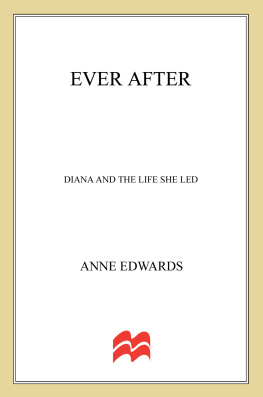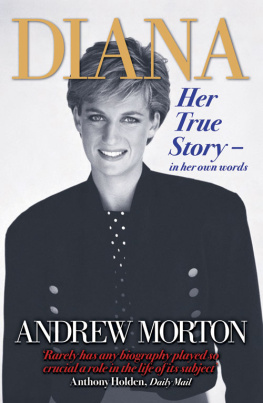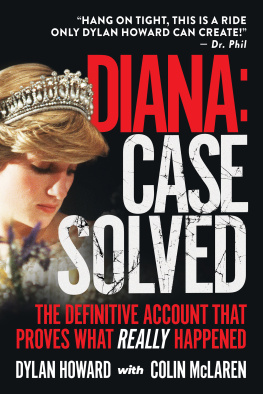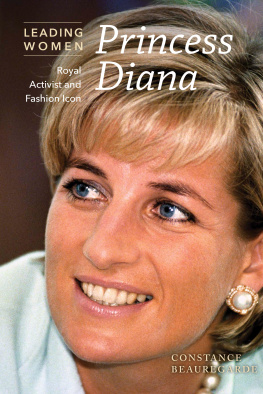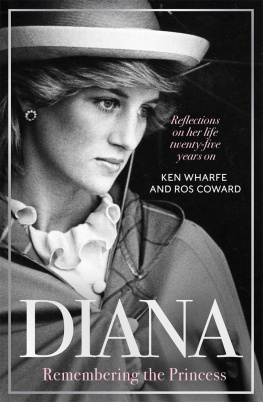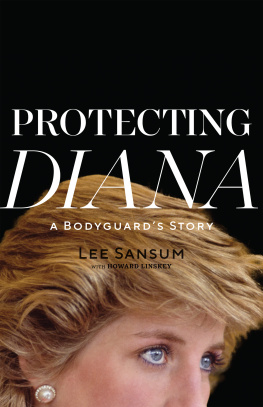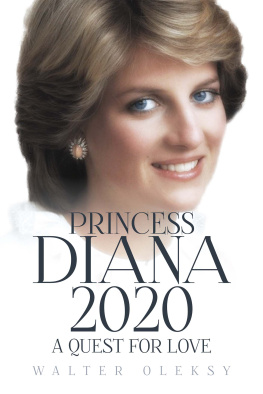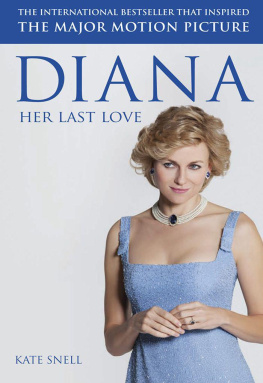EVER AFTER
DIANA AND THE LIFE SHE LED
ANNE EDWARDS

St. Martins Paperbacks
The author and publisher have provided this e-book to you for your personal use only. You may not make this e-book publicly available in any way. Copyright infringement is against the law. If you believe the copy of this e-book you are reading infringes on the authors copyright, please notify the publisher at: http://us.macmillanusa.com/piracy.
F OR C ATHERINE S ADLER G RILL WITH LOVE
A V ISIT TO A LTHORP
1964
A T THE AGE of three Diana Spencer was taken on a rare visit to see her paternal grandparents, the Earl and Countess Spencer, at Althorp House in Northamptonshire, on what was intended to be an occasion of great celebration. Her mother had produced a healthy male heir for the House of Spencer, which had featured prominently in the history of England since the mid-sixteenth century. The young heir, her infant brother Charles, was screaming in his nannys arms unaware that one day he would inherit a substantial fortune, an earldomgranted originally by Charles Iand the massive estate whose noble halls, on this crisp autumn day in 1964, echoed to his bawling cries. Diana knew there was something special about Charles that made him more important to her parents than either she or her two older sisters, Sarah and Jane: since his birth there had been an air of jubilation in their home, Park House near Kings Lynn.
After the rail journey, the family was met at Northampton station by the Earls dark green Rolls-Royce, adorned with the Spencer crest, and driven the remaining six miles to Althorp. The splendid Tudor mansion, with its vast acreage, had been home to the Spencer family since 1508. The current Earl was vigorously protective of his cars so the chauffeur drove slowly along the Northampton-Rugby road, through small villages whose inhabitants had been reliant for generations upon the successive masters of Althorp for their livelihood.
At last the car passed through the gates of Althorp and continued on beneath an arch of ancient oaks to the front entrance where the Earl and Countess were standing. Upon arrival, Dianas mother Frances, a tall, lean, blonde woman, pushed forward the little girl at her side and let go of her hand. This is Diana, the shy one, she announced.
Diana gazed up at the gruff, unsmiling face of her grandfather, Albert (Jack) Edward John Spencer, the 7th Earl Spencer. Later she recalled being too terrified to speak as he grunted something at her, then turned his back and walked away.
A moment later her grandmother, Cynthia, bent down, took her hand and said, Well, Diana, you certainly have grown into a lovely big girl. These words, with minor revisions appropriate to Dianas passage from childhood to adolescence, were repeated on all her future visits to Althorp until her grandmothers death.
Diana adored her grandmother, in whose presence she always felt protected. She was still lovely, with softly waved silver hair and deep blue eyes, and a warm, genuine smile. It was she who kept the peace between her rather brusque husband and his family.
On that day, Cynthia led Diana across the black and white checkered marble floor of the hall, up the deep steps of the grand, balustered staircase. They went along a wide corridor hung with portraits of men in uniform, swords at their sides, and bejewelled women, until eventually Countess Spencer opened a door into a soft blue and delicately flowered sitting room. This was my favourite book as a child, she said as she retrieved a book with a brightly coloured cover from a glass-fronted cabinet. I would like you to have it now. It was an illustrated edition of Grimms Fairy Tales, which Diana treasured for the rest of her life.
Diana never knew her grandfather well, for Jack Spencer had little interest in his family. Althorp was his passion and he had great pride in his Spencer heritage which he considered, because of its solid English roots, of a higher order than that of the Windsors. That dynasty had been founded by the Hanoverian George I in 1714, four centuries after William Spencer, an English sheep-farmer, had become a prominent landowner. Jack Spencer had one son, Dianas father Edward JohnJohnnieViscount Althorp, for whom he had small regard. Johnnie lacked intellectual curiosity, and he had little respect for the history of the earldom that he would one day inherit Neither could he manage his income. He drank heavily, and family rumour ran that he had struck Frances more than once.
Diana was fascinated by the family portraits, so much so that it would not take too many years before she would be well-schooled in her family history. She made a practice of interweaving the basic facts about the Spencers with those she learned about the kings and queens of England. For instance it was Sir John Spencer (153399) who had built Althorp and founded the family fortunes during the reigns of Henry VIII and Elizabeth I. His son-in-law Thomas Sackville, Earl of Dorset, Lord Treasurer and Lord High Steward had been given the awesome task in 1587 of informing Mary Queen of Scots that she had been sentenced to death, and in 1600 had presided over the trial for disobedience of the Earl of Essex.
More than a hundred portraits and paintings, by Van Dyck and Gainsborough among others, hung in Althorps spectacular Long Gallery. Diana came to know the history of most of their subjects. There were also portraits of many of the estates illustrious royal guests: Queen Anne, James Fs consort; King Charles I and his queen, Henrietta Maria; King Edward VII; King George V and VI and their queens, Mary and Elizabeth; and the Empress of Austria were only a few among the many who enjoyed its ambience, hunt parties and fine library.
Among Dianas antecedents were ambassadors, privy councillors and Knights of the Garter. There were intellectuals, politicians, poets and philosophersphilanderers and Philistines too. She was related to Charles II, seven American presidents, and the distinguished Suffolk, Sunderland, Shaftesbury, Marlborough, Abercorn, Seymour, Halifax, Devonshire, Peel, Baring and Churchill families. Through the Suffolks the Spencers were directly descended from King Henry VII. They could also claim descent from Sir Robert Walpole, usually regarded as the first prime minister, the great Duke of Marlborough and the ill-fated Lady Jane Grey. Diana was proud of her Spencer ancestry and when at times she faced confrontation, she would say to herself, Remember, Diana, you are a Spencer.
Diana took away from her first visit to Althorp the warm memory of Grandmother Spencer, and a sense of apprehension when she thought of her grandfather, whose oppressive personality pervaded the great house. Later in life she said she could feel his presence minutes before he entered a room. Of that visit she also recalled that her parents had abruptly gathered together their children and departed hurriedly, her fathers face red and unsmiling, her mother silent until they were on their way home to Park House. Then there was a row. Diana never knew what had been the cause, but it left her with a sense of foreboding that shadowed her childhood and followed her throughout her life.
D IANAS GRANDFATHER DEVOTED his life to the preservation of Althorp. He had little time for frivolity and had no patience with fools or children. A blunt man, he would say and do precisely what he thought true and right without the faintest regard for the reaction his words or deeds might produce.

